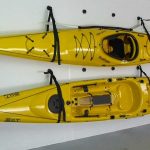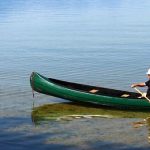To get the best value out of your canoe, it’s critical to store it correctly so its lifespan is extended. You don’t want to finish off with a dull and tattered canoe that is filled with insects and other small animals.
However, there are good methods and bad methods of keeping a canoe. We have compiled some advice for keeping your canoe safe, no matter if it is stored outside or inside.
Why Canoe Storage Is So Important
Prevents Damage
Storing your canoe is essential as it helps guard against any potential damage. This can help extend the lifespan of your canoe. Harm can be inflicted due to the meteorological conditions or the area in which the canoe is kept.
Canoe storage is particularly essential if you intend to leave the canoe unattended for an extended interval, such as during the winter season.
If you do not store your canoe correctly, the weight of the canoe itself can cause harm to the body. The shape of the canoe may be distorted, which can have an effect on the vessel’s agility and resilience in the water.
You should not leave the canoe with its underside against the ground. It should ideally be stored upside down.
The hull can be damaged by exposure to the sun and hot temperatures, leading to discoloration and cracking. The ultraviolet radiation from the sun can degrade the structural integrity of the hull, causing it to weaken. This can occur if you keep your canoe outdoors without any cover, exposed to bad weather.
Your canoe can be ruined by low temperatures if you don’t store it correctly in cold climates. Fiberglass canoes may be more prone to being harmed by frigid temperatures.
Making sure your canoe is stored properly reduces the possibility of it being harmed by outside sources.
Keeping away rodents that are seeking a place to hibernate during the winter can be a beneficial element in organizing both indoor and outdoor storage.
Remember, never use your canoe as a storage container. Keeping heavy equipment inside the canoe while it is not in use can harm the shape of the hull. Additionally, it will affect the weight distribution.
Deters Thieves
No one desires to go back to their canoe just to discover that it has been taken away. Safely stowing your canoe can keep criminals from attempting to take it.
If a canoe is out in the open, it may be more attractive to a criminal than one kept out of sight.
Keeping items indoors can generally be more effective in discouraging burglars. Even though you may be storing your canoe out of doors, it would be beneficial to invest in a cover for it both to stop anyone stealing it and to protect its hull.
Inside vs Outside Canoe Storage
Indoors
Keeping a canoe indoors can be the most beneficial method for protecting your boat from harm and increasing its durability. Making it harder for someone to enter the garage or inside space can help to prevent theft, as you can put a lock on it.
If you can, avoid keeping a canoe near windows or in direct sunlight while inside, as this will help minimize the amount of UV light that hits it.
Storing your canoe inside can ensure that it is kept in a more stable temperature. It is possible that your indoor setting will not hold up if the temperatures are too severe, like if you don’t have any AC or furnace in place (depending on your geographic area).
It might be sensible to put your canoe someplace that is not exposed to any heat sources, like a boiler or hot water tank.
Outdoors
If you have no other choice but to keep your canoe outside, make sure you have it protected with a cover. This can provide protection from the sun and harmful weather conditions. It may not be possible to stop any harm from very hot or cold temperatures if you keep your canoe outside.
Unless you are looking to construct a specially tailored shed or covering along the side of your house, you may find a tarp to be beneficial in offering protection. Be certain that the tarp does not lie directly over the canoe, as this can lead to dampness accumulating.
Some canoeists may also make use of the area beneath a deck for storage in their yard.
How to Create Proper Supports
As a rule, the ideal storage supports that connect with the upside-down canoe’s gunwales should have a few important characteristics:
Have at Least Two Supports
It is necessary that there be a minimum of two. In most cases, it is not beneficial to have more than two people in a canoe, unless, of course, it is a gigantic 21-foot, three to four-person canoe, which could accommodate an additional support person.
Parallel to the Ground
The supports should be nearly parallel with the ground. It is factual that yacht kayaks situated with a lean can twist after a period of time, combined with being exposed to the various conditions such as heat and cold, humidity and aridity.
Gravity Can Cause Warping
If the supports create a tilt in the canoe and pull it onto a wall or other surface, it is possible that the force of gravity could damage the hull.
For your canoe storage arms or braces to be effective, it is necessary that they are as close as possible to being parallel to each other, as this will prevent the hull from being deformed as a result of gravity. It is recommended that a level is employed when putting up the support arms to make certain they are precisely the same in their slant.
Proper Spacing Can Save Your Canoe!
The utmost priority when constructing a canoe storage system with armatures is to be mindful of the intervals between them. The distance of each of the 2 support arms should be approximately 1/3 of the length of the canoe away from the boat’s extremities.
If you space them further apart than one third of an inch, the canoe might not be secure in some circumstances. If you position the seats closer to the bow and the stern, there is a risk that gravity may cause the center of the canoe to sink down, leading to the floor of the canoe having a higher elevation in the middle than at the front and back.
| Length of Canoe | Distance From One Brace to the Other |
| 12 feet | 4 feet |
| 14 feet | 4 feet, 8 inches |
| 16 feet | 5 feet, 4 inches |
| 18 feet | 6 feet |
| 20 feet | 6 feet, 8 inches |
If you are storing canoes of different sizes with a multi-canoe rack system such as the one in the illustration, keep the brackets a bit closer together. Canoes are more likely to get damaged if the supports are spaced too far apart rather than if they are too close together.
How to Store a Canoe Outside in Any Weather
It has been suggested by some specialists that the most suitable spot to keep a canoe is indoors. But what about those who don’t have indoor space? Is it okay to store your canoe outside?
It is possible to store a canoe outside provided there is a roof or eave to shield it from the elements, or a covering of breathable, waterproof material that does not come into contact with the body of the canoe. Porches, sheds, carports, awnings, and overhangs are ideal protectors.
Since you do not have your canoe inside, you have relinquished your best benefit in regard to keeping it looking fresh and safe from being stolen or harmed. However, not all is lost.
It is wise to manage the aspects you have the power to alter. Ensure that you place your canoe gunwales down on a robust structure, such as 2×4’s, as was outlined earlier, for the best storage.
Acquiring or constructing a canopy or any type of overhang would be advantageous for shielding from the sun, snow, ice and moisture. Wind protection may also need to be considered.
Should You Cover Your Canoe?
Putting a plastic tarp over a canoe can be a dangerous task. You should take steps to shield it from UV and snow, but unless caution is taken, it could become moldy and lose its color.
If no outdoor shelter is accessible, the canoe should be protected with a tarp that allows air to pass through it and is impermeable to water. To ensure that it doesn’t directly touch the hull, foam blocks or some other similar item should be used.
A typical plastic cover cannot allow air to pass, and over time will cause mildew and fading of the canoe beneath it.
An expenditure on a tarp that allows air to flow through it and is waterproof is not a trifling outlay, however it is your wise choice for protection if you are unable to place your canoe indoors, in a structure, or in a covered outside area.
Protection from Mold
Having opted for the breathable tarp since you don’t have the space for your canoe in your carport or store, you should make sure you take one last significant safety measure. When you put a tarp over the canoe, you must make absolutely sure that the tarp is not touching the hull of the boat. I have found that the most successful way to go about it is to utilize the four foam blocks that could have been employed for securing your canoe to your vehicle.
It would be advantageous to own a group of substantial partitioners for your tarp even if you’re not taking advantage of the blocks – it would be worth the purchase. There are a variety of methods you can use to make sure your tarp is secure, depending on how you are keeping it. You can secure it with two or more cinder blocks, or attach it to the bottom of the stand where it’s kept.
Canoe Covers
As an option to an air-permeable, water-proof tarp, a canoe cover built particularly for that purpose could be used. Many people will proclaim they are prepared to start and provide absolute defense. It is important to make sure that the tarp is not in constant and complete contact with the hull.
Placing a couple of Styrofoam blocks on the upside-down boat should get the job done.
How to Keep Your Canoe Secure Outdoors
Depending on your location and how apparent your canoe is to people, you may have to implement something to safeguard it so it does not get taken without you knowing in the middle of the night!
The most reliable way to ensure the safety of a canoe stored outside is to keep the knowledge of its location a secret, and if possible, to store it in a place where it would be very difficult to transport away. An illustration of this would be a yard that is enclosed by a tall fence and a locked gate, with no way inside apart from that entrance.
It is practical to suggest that there are several methods you can use to discourage or keep off even the most determined thief. If you have a Tug Eye (a hole in the front of the canoe), it is recommended to thread a strong rope (or two if desired) through it and tie it to a large tree.
Putting a Kryptonite cable underneath all the boats’ structural supports, seat arrangements, and hand-holds would be a great way to discourage stealing.
How Do You Lock Up A Canoe?
The best solution to protect your canoe is to store it inside a sheltered area with a locking mechanism, such as a garage.
If you have your canoe outside, or you want to add more protection for indoor storage, a cable lock is a great way to keep it safe from theft (it’s better than nothing).
A cable lock that is resistant to the weather might be great for securing your canoe while it is outdoors. In order to secure your canoe, pass a cable through one of the handles and tie it to a strongly anchored spot, such as a wall rack, a post, or a tree.
It might be a good idea to secure your belongings with more than one cable lock. Attach a cable lock to each of the handles and affix them to something that cannot be moved.
Make sure to keep your canoe out of sight, away from windows, even if you believe that it is secure. It is unlikely that thieves will take what they cannot view. It is advisable to utilize a secure lock even if you attempt to conceal your canoe.
Conclusion
Learning the correct way to keep your canoe can lengthen its lifespan and aid you in getting your money’s worth out of it.
The optimal location to keep a canoe is indoors, out of direct sunlight and away from exceptionally cold or hot temperatures. Both inside and outside storing methods can be beneficial, yet keeping the canoe inside is usually the most appropriate.
Keep in mind that you shouldn’t keep the canoe against the earth and that you should make certain the weight is spread equivalently the entire length of the boat. Do you have any advice that you would like to give us?




